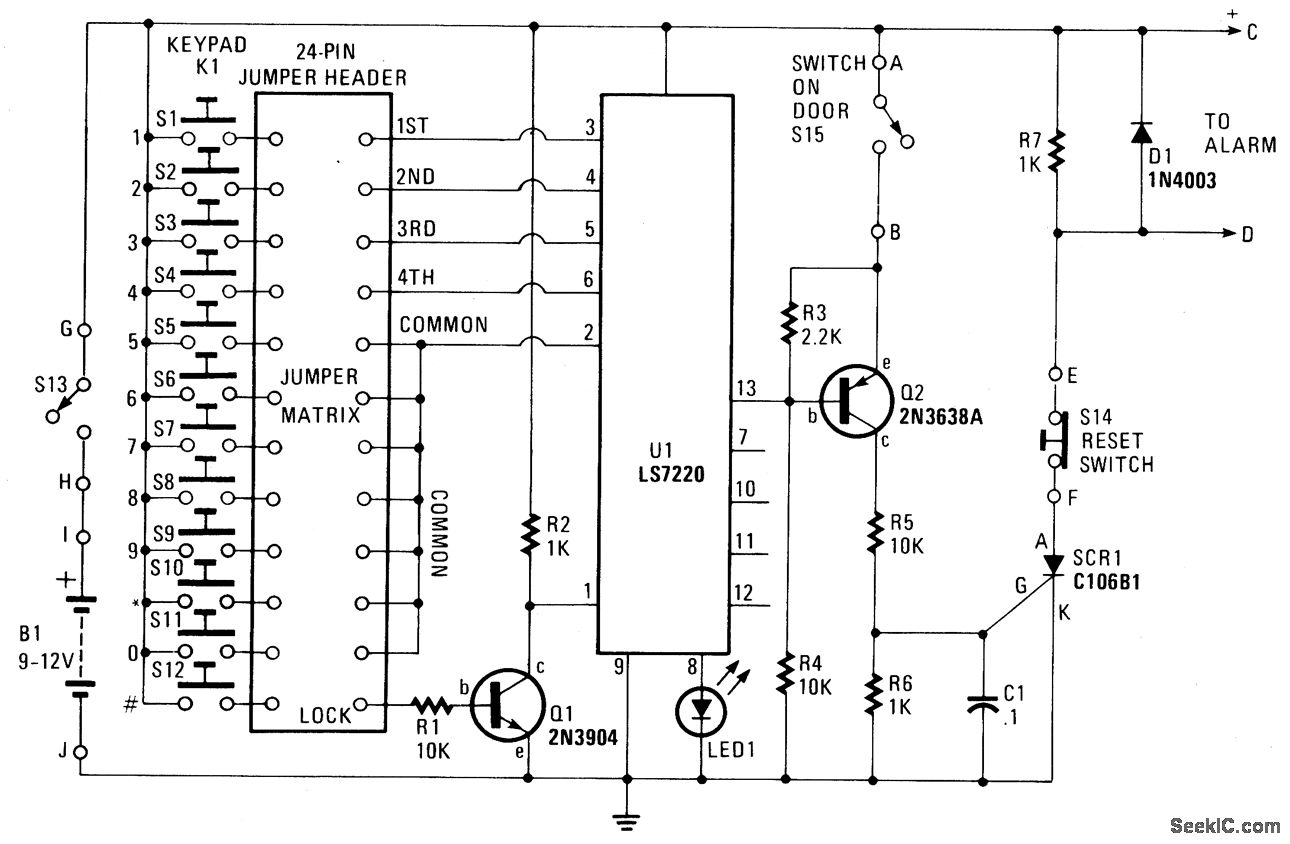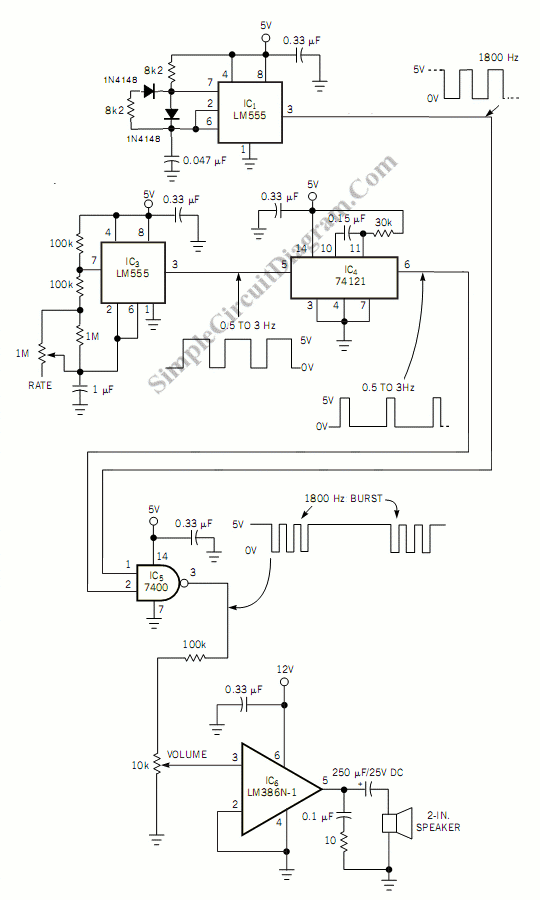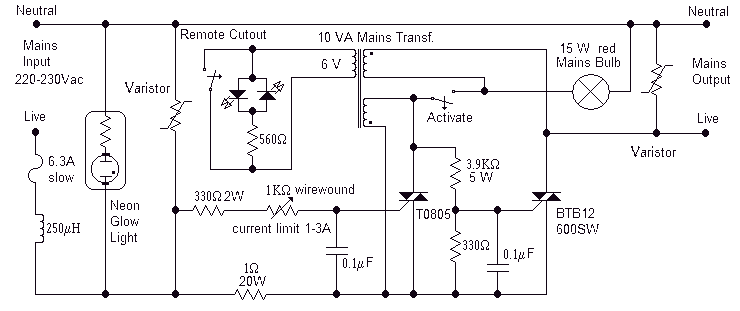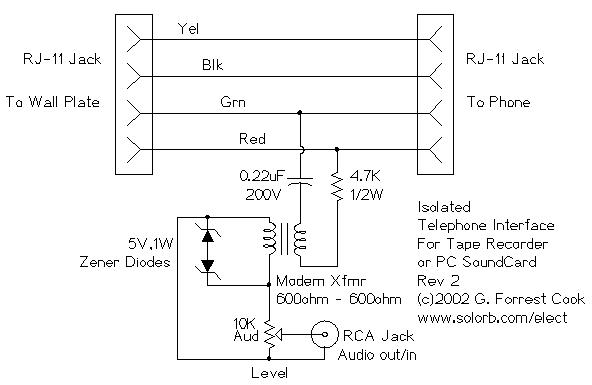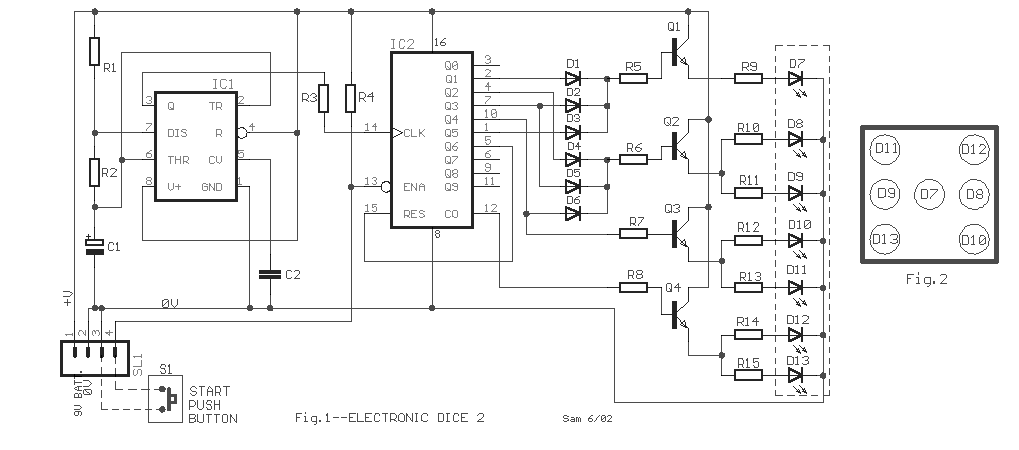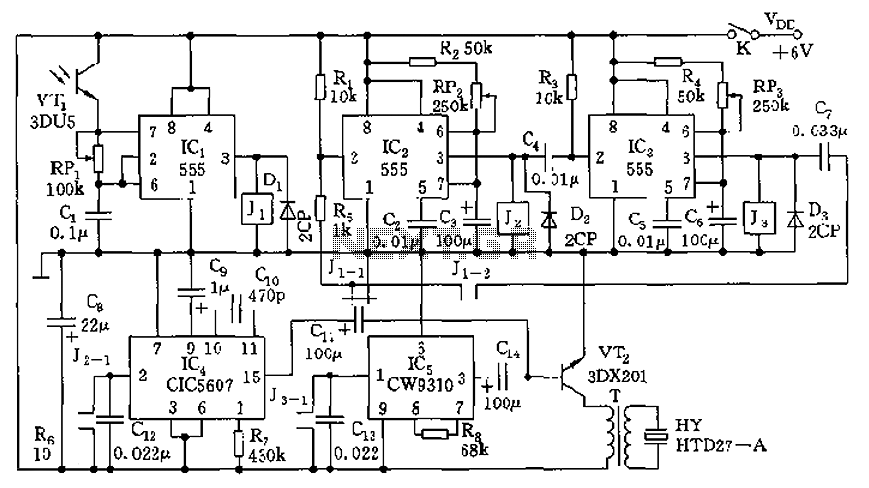
Electronic mosquito repeller
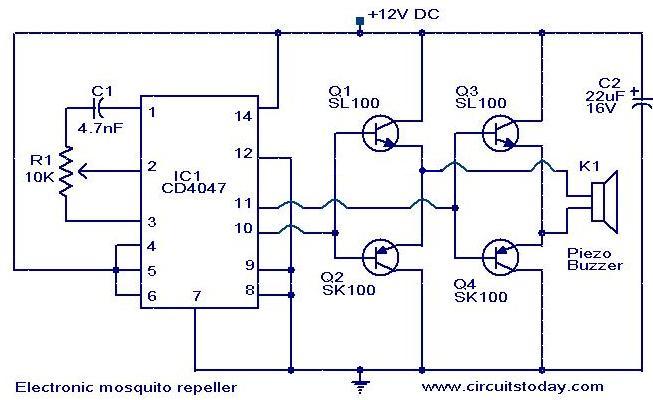
The circuit diagram of an ultrasonic mosquito repeller is based on the principle that insects, such as mosquitoes, can be repelled using sound frequencies in the ultrasonic range (above 20 kHz). The circuit utilizes a CMOS 4047 PLL IC configured as an oscillator operating at 22 kHz. A complementary symmetry amplifier, composed of four transistors, amplifies the sound signal. The output of the amplifier drives a piezo buzzer, which converts the amplified signal into ultrasonic sound, inaudible to humans but effective in repelling insects. The circuit design allows for adjustments in frequency by modifying resistor R1 and capacitor C1 values, enabling operation in various frequency ranges.
The CMOS 4047 IC serves as the heart of the circuit, generating a square wave output at a frequency determined by the external components R1 and C1. The complementary outputs from pin 10 and pin 11 of the IC feed into the bridged push-pull output configuration formed by the four transistors. This arrangement effectively increases the output power fourfold compared to a standard push-pull configuration with two transistors, allowing for greater sound amplification.
The piezo transducer is chosen for its ability to respond effectively to ultrasonic frequencies, making it preferable over standard speakers for this application. The circuit also includes a coupling capacitor that can be adjusted to modify the frequency output; for example, using a parallel capacitor with C1 can shift the frequency into the audible range for testing purposes.
In terms of component selection, R1 and C1 can be varied to achieve different frequencies, such as 1000 kHz with R1 at 22 kΩ and C1 at 10 pF, or 20 kHz with R1 halved to 11 kΩ or C1 halved to 500 pF. The circuit also employs an electrolytic capacitor (C2) with a voltage rating that should be specified in the schematic, as well as a ceramic capacitor (C1) typically rated between 50V and 400V.
Regarding sound level indicators, they measure sound levels within the human audible range, while the ultrasonic repeller operates outside this range. Some reports suggest that electronic mosquito repellents may not be effective, prompting users to verify their circuit functionality and component connections. For those interested in creating a variable frequency mosquito repellent, modifications to the resistor and capacitor values can achieve a frequency range from 16 kHz to over 45 kHz, allowing for customization based on specific needs.
Overall, this ultrasonic mosquito repeller circuit combines efficient sound generation and amplification techniques to create a device aimed at repelling mosquitoes effectively through ultrasonic sound waves.Here is the circuit diagram of an ultrasonic mosquito repeller. The circuit is based on the theory that insects like mosquito can be repelled by using sound frequencies in the ultrasonic (above 20KHz) range. The circuit is nothing but a PLL IC CMOS 4047 wired as an oscillator working at 22KHz. A complementary symmetry amplifier consisting of four tra nsistor is used to amplify the sound. The piezo buzzer converts the output of amplifier to ultrasonic sound that can be heard by the insects. Hello, Im an norwegian engineer-student, and I am having your circuit as a project, both making and attempting to explain it.
Making it wont be that much of a problem, but understanding it is a little more tricky. I wondered if you could explain a little bit how/why you have used 4 transistors, for example, and why this circuit will work the way it does. Hi This is called bridged push pull output. This circuit will provide 4 times the normal 2 transistor push pull output connecting through a coupling capacitor.
IC 4047 is an oscillator whose frequency is set by R1 & C1. The complimentary output of the IC which is available on pin no 10 & 11 are fed to the bridged output circuit. Since the frequency used for repelling mosquitoes is in the ultrasonic range a piezo transducer, which respond to Ultrasonic sound better is used for producing sound, instead of standard loud speaker.
We`re a group of volunteers and opening a brand new plan in our little local community. Your website offered us with beneficial info to work on. You have done a striking position and our complete community shall be thankful to you. Hi Susan connect 4. 7nF in parallel to C1 the oscillator frequency will be in audible range. now check any out put is there if not check all the components and IC pin connections. if it gives audible sound, remove the capacitor connected in parallel, the circuit is ready for use. Piezotransducer will emit the in audible signal of the oscillator. sound level indicator is an equipment to measure the sound level (noise level) in an environment. they operate in human audible range only. ScienceDaily (Apr. 18, 2007) ” Electronic mosquito repellents ” buzzing devices marketed to prevent malaria ” don`t prevent bites and therefore don`t prevent disease transmission, according to a new review of studies. . . is this true If you use R1 as 22K and C1 as 10PF tha frequency out will be 1000kHz, similarly for 10 kHz C1 should be 100pF and R1 should be 220k or 22k and 1000pF.
for 20kHz either you make C1 half (500pF) the value or R1 (11k)half the value(as the formula is inversely proportional) C2 is an electrolytic capacitor and they are available in different voltage ratings, from few volts to hundreds of volts and thats why its a common practice to represent the voltage rating of electrolytic capacitors in the circuit diagram. C1 is a ceramic capacitor and the commonly available ones are rated from 50V to 400V. Some manufacturers represent the voltage rating using some code while others not. Any way we can guess that a commonly available ceramic disc capacitor will be rated at least 50V or so.
Hi Zaman these small speakers may not respond beyond 11 to 12kHz. only hi-fi tweeters can respond they will be quite expensive. Hence Piezo tweeters are quite in expensive. this is normally used as additional attachment with car system speakers or part of portable sound system. you can use them. I assembled mosquito repellent circuit. I am observing, mosquitoes are not affected by this. I don`t know whether the circuit is working or not. I used a piezo tweeter which works with 8000+ frequencies which I can hear (in other tests). I want to know where to be connected with No 2 leg of IC 4047. Can you please suggest me in this regard If it works, I want to assemble few more for our use. Can you suggest me how to make a mosquito repellent with Variable Frequency (from 16 kHz to 45 kHz+) with sufficiently po
🔗 External reference
The CMOS 4047 IC serves as the heart of the circuit, generating a square wave output at a frequency determined by the external components R1 and C1. The complementary outputs from pin 10 and pin 11 of the IC feed into the bridged push-pull output configuration formed by the four transistors. This arrangement effectively increases the output power fourfold compared to a standard push-pull configuration with two transistors, allowing for greater sound amplification.
The piezo transducer is chosen for its ability to respond effectively to ultrasonic frequencies, making it preferable over standard speakers for this application. The circuit also includes a coupling capacitor that can be adjusted to modify the frequency output; for example, using a parallel capacitor with C1 can shift the frequency into the audible range for testing purposes.
In terms of component selection, R1 and C1 can be varied to achieve different frequencies, such as 1000 kHz with R1 at 22 kΩ and C1 at 10 pF, or 20 kHz with R1 halved to 11 kΩ or C1 halved to 500 pF. The circuit also employs an electrolytic capacitor (C2) with a voltage rating that should be specified in the schematic, as well as a ceramic capacitor (C1) typically rated between 50V and 400V.
Regarding sound level indicators, they measure sound levels within the human audible range, while the ultrasonic repeller operates outside this range. Some reports suggest that electronic mosquito repellents may not be effective, prompting users to verify their circuit functionality and component connections. For those interested in creating a variable frequency mosquito repellent, modifications to the resistor and capacitor values can achieve a frequency range from 16 kHz to over 45 kHz, allowing for customization based on specific needs.
Overall, this ultrasonic mosquito repeller circuit combines efficient sound generation and amplification techniques to create a device aimed at repelling mosquitoes effectively through ultrasonic sound waves.Here is the circuit diagram of an ultrasonic mosquito repeller. The circuit is based on the theory that insects like mosquito can be repelled by using sound frequencies in the ultrasonic (above 20KHz) range. The circuit is nothing but a PLL IC CMOS 4047 wired as an oscillator working at 22KHz. A complementary symmetry amplifier consisting of four tra nsistor is used to amplify the sound. The piezo buzzer converts the output of amplifier to ultrasonic sound that can be heard by the insects. Hello, Im an norwegian engineer-student, and I am having your circuit as a project, both making and attempting to explain it.
Making it wont be that much of a problem, but understanding it is a little more tricky. I wondered if you could explain a little bit how/why you have used 4 transistors, for example, and why this circuit will work the way it does. Hi This is called bridged push pull output. This circuit will provide 4 times the normal 2 transistor push pull output connecting through a coupling capacitor.
IC 4047 is an oscillator whose frequency is set by R1 & C1. The complimentary output of the IC which is available on pin no 10 & 11 are fed to the bridged output circuit. Since the frequency used for repelling mosquitoes is in the ultrasonic range a piezo transducer, which respond to Ultrasonic sound better is used for producing sound, instead of standard loud speaker.
We`re a group of volunteers and opening a brand new plan in our little local community. Your website offered us with beneficial info to work on. You have done a striking position and our complete community shall be thankful to you. Hi Susan connect 4. 7nF in parallel to C1 the oscillator frequency will be in audible range. now check any out put is there if not check all the components and IC pin connections. if it gives audible sound, remove the capacitor connected in parallel, the circuit is ready for use. Piezotransducer will emit the in audible signal of the oscillator. sound level indicator is an equipment to measure the sound level (noise level) in an environment. they operate in human audible range only. ScienceDaily (Apr. 18, 2007) ” Electronic mosquito repellents ” buzzing devices marketed to prevent malaria ” don`t prevent bites and therefore don`t prevent disease transmission, according to a new review of studies. . . is this true If you use R1 as 22K and C1 as 10PF tha frequency out will be 1000kHz, similarly for 10 kHz C1 should be 100pF and R1 should be 220k or 22k and 1000pF.
for 20kHz either you make C1 half (500pF) the value or R1 (11k)half the value(as the formula is inversely proportional) C2 is an electrolytic capacitor and they are available in different voltage ratings, from few volts to hundreds of volts and thats why its a common practice to represent the voltage rating of electrolytic capacitors in the circuit diagram. C1 is a ceramic capacitor and the commonly available ones are rated from 50V to 400V. Some manufacturers represent the voltage rating using some code while others not. Any way we can guess that a commonly available ceramic disc capacitor will be rated at least 50V or so.
Hi Zaman these small speakers may not respond beyond 11 to 12kHz. only hi-fi tweeters can respond they will be quite expensive. Hence Piezo tweeters are quite in expensive. this is normally used as additional attachment with car system speakers or part of portable sound system. you can use them. I assembled mosquito repellent circuit. I am observing, mosquitoes are not affected by this. I don`t know whether the circuit is working or not. I used a piezo tweeter which works with 8000+ frequencies which I can hear (in other tests). I want to know where to be connected with No 2 leg of IC 4047. Can you please suggest me in this regard If it works, I want to assemble few more for our use. Can you suggest me how to make a mosquito repellent with Variable Frequency (from 16 kHz to 45 kHz+) with sufficiently po
🔗 External reference
